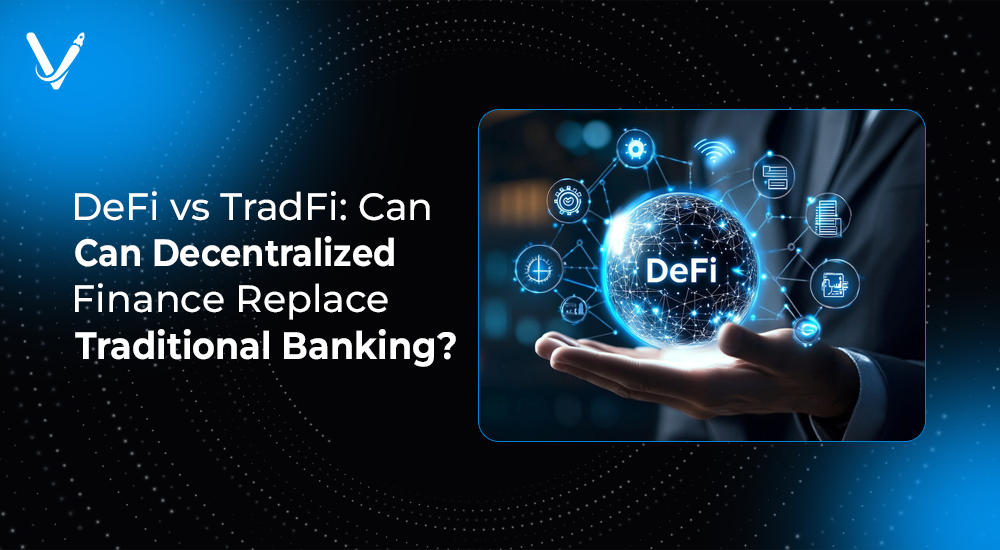DeFi vs TradFi: Can Decentralized Finance Replace Traditional Banking?


- May 17, 2025



The financial landscape is undergoing a profound transformation driven by blockchain technology. Decentralized finance (DeFi) is emerging as a revolutionary force, challenging the long-standing dominance of traditional finance (TradFi). With DeFi promising borderless transactions, peer-to-peer lending, and transparent systems, many are questioning the future of conventional banking. But can DeFi truly replace the global banking infrastructure, or will it coexist as a complementary system?
This comprehensive guide delves into the core differences between DeFi and TradFi, examines their respective strengths and weaknesses, and explores whether DeFi has the potential to redefine finance as we know it.
Before diving into the battle between DeFi and TradFi, it is essential to understand the fundamental concepts behind these financial systems. Both operate with distinct mechanisms, yet share a common goal: facilitating financial transactions and services. While TradFi relies on centralized intermediaries like banks and financial institutions, DeFi leverages blockchain technology to eliminate middlemen. This section explores the defining characteristics of both systems, providing a solid foundation for further analysis.
DeFi, or decentralized finance, refers to a financial ecosystem built on blockchain networks. Unlike traditional banking systems, DeFi eliminates intermediaries by utilizing smart contracts, enabling peer-to-peer transactions. This decentralized structure provides greater financial inclusivity, allowing anyone with internet access to participate in financial activities without the need for conventional banking.
Key components of DeFi include decentralized exchanges (DEXs), lending platforms, stablecoins, and prediction markets. These platforms operate on blockchain networks such as Ethereum, Binance Smart Chain, and Solana, ensuring transparency, security, and global accessibility.
Key Components of DeFi:
Examples of DeFi Platforms:
Traditional finance (TradFi) represents the conventional banking system that has been the backbone of the global economy for decades. It encompasses banks, insurance companies, payment processors, and investment firms that operate under strict regulatory frameworks. Unlike DeFi, TradFi relies on intermediaries to facilitate transactions, ensuring consumer protection through regulatory oversight.
TradFi institutions are governed by financial authorities such as central banks and regulatory bodies. This structure provides a sense of security, but it also introduces high fees, slower transaction speeds, and limited accessibility for underserved populations.
Key components of TradFi include centralized exchanges, banks, insurance firms, and payment processors.
Examples of TradFi Institutions:
To understand whether DeFi can replace TradFi, it is essential to examine the key differences between the two systems. Both serve similar functions, such as lending, borrowing, trading, and investing, but their underlying structures are fundamentally different. This section analyzes how DeFi and TradFi differ in terms of control, transparency, costs, efficiency, and regulation.
Control over financial assets is a crucial distinction between DeFi and TradFi. In DeFi, users retain control of their funds through private keys, enabling direct asset management. In contrast, TradFi institutions act as custodians of funds, controlling access to financial assets.
DeFi operates on permissionless networks, allowing anyone with an internet connection to participate in financial activities. This inclusivity empowers the unbanked to access services like lending and borrowing without traditional credit checks. TradFi, however, restricts access to individuals with verified identities, imposing barriers to entry for marginalized populations.
Transparency is a defining feature of DeFi. Blockchain networks record every transaction on a public ledger, ensuring that data is immutable and accessible to all participants. This transparency reduces the risk of fraud and promotes accountability.
TradFi relies on private databases maintained by centralized institutions. While this structure enhances data privacy, it also creates vulnerabilities to data breaches and insider manipulation. Moreover, traditional banks can freeze accounts or restrict access to funds, a risk absent in DeFi systems where users maintain control through private keys.
Cost efficiency is another critical factor in the DeFi vs TradFi debate. DeFi reduces costs by eliminating intermediaries, allowing for peer-to-peer transactions. However, blockchain networks like Ethereum impose gas fees, which can be unpredictable during periods of high demand.
TradFi charges fees for various services, including account maintenance, wire transfers, and international payments. These fees vary based on the institution and the service provided, often resulting in higher overall costs compared to DeFi.
Transaction speed is a significant advantage of DeFi. Blockchain networks operate 24/7, enabling real-time settlements regardless of banking hours. This round-the-clock accessibility is particularly beneficial for cross-border transactions, which can be completed in minutes.
TradFi transactions can take days to settle, especially for international transfers. The reliance on intermediaries and regulatory checks contributes to these delays, impacting overall efficiency.
The regulatory landscape is one of the most contentious aspects of DeFi. While TradFi operates under stringent regulatory frameworks that protect investors and enforce legal standards, DeFi remains largely unregulated.
Regulatory uncertainty in DeFi raises concerns about fraud, money laundering, and investor protection. Recent crackdowns on DeFi platforms like Tornado Cash highlight the potential risks associated with unregulated financial systems.
In contrast, TradFi institutions are required to comply with anti-money laundering (AML) and know-your-customer (KYC) regulations, providing an additional layer of security for users.
DeFi offers numerous advantages over traditional finance, particularly in terms of accessibility, transparency, and asset ownership. This section explores how DeFi empowers users by eliminating intermediaries, reducing costs, and democratizing financial services.
Despite its advantages, DeFi is not without its drawbacks. Market volatility, smart contract vulnerabilities, and regulatory risks pose significant challenges to widespread adoption. This section examines the limitations of DeFi, highlighting the key obstacles that must be addressed for it to compete with TradFi.
The real-world impact of DeFi and TradFi can be observed through case studies of prominent platforms. This section analyzes the success of Aave in the DeFi sector and JPMorgan’s blockchain initiative in the TradFi sector, demonstrating how both systems are evolving to meet user demands.
The debate over whether DeFi can replace TradFi remains ongoing. While DeFi introduces groundbreaking innovations, TradFi institutions are also adopting blockchain technology to enhance operational efficiency. This section explores the potential for a hybrid financial ecosystem that combines the strengths of both systems.
DeFi presents a compelling alternative to traditional banking, offering increased transparency, financial inclusivity, and cost efficiency. However, regulatory uncertainty and market risks remain significant challenges. While DeFi may not entirely replace TradFi, a convergence of both systems is likely as blockchain technology continues to evolve. Vasundhara Infotech specializes in Blockchain Development, providing tailored solutions for businesses seeking to integrate DeFi services. Connect with our experts to explore how decentralized finance can enhance your business operations.
Copyright © 2025 Vasundhara Infotech. All Rights Reserved.